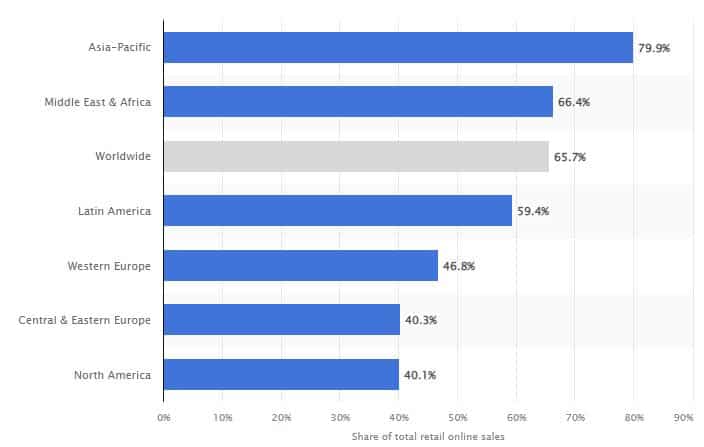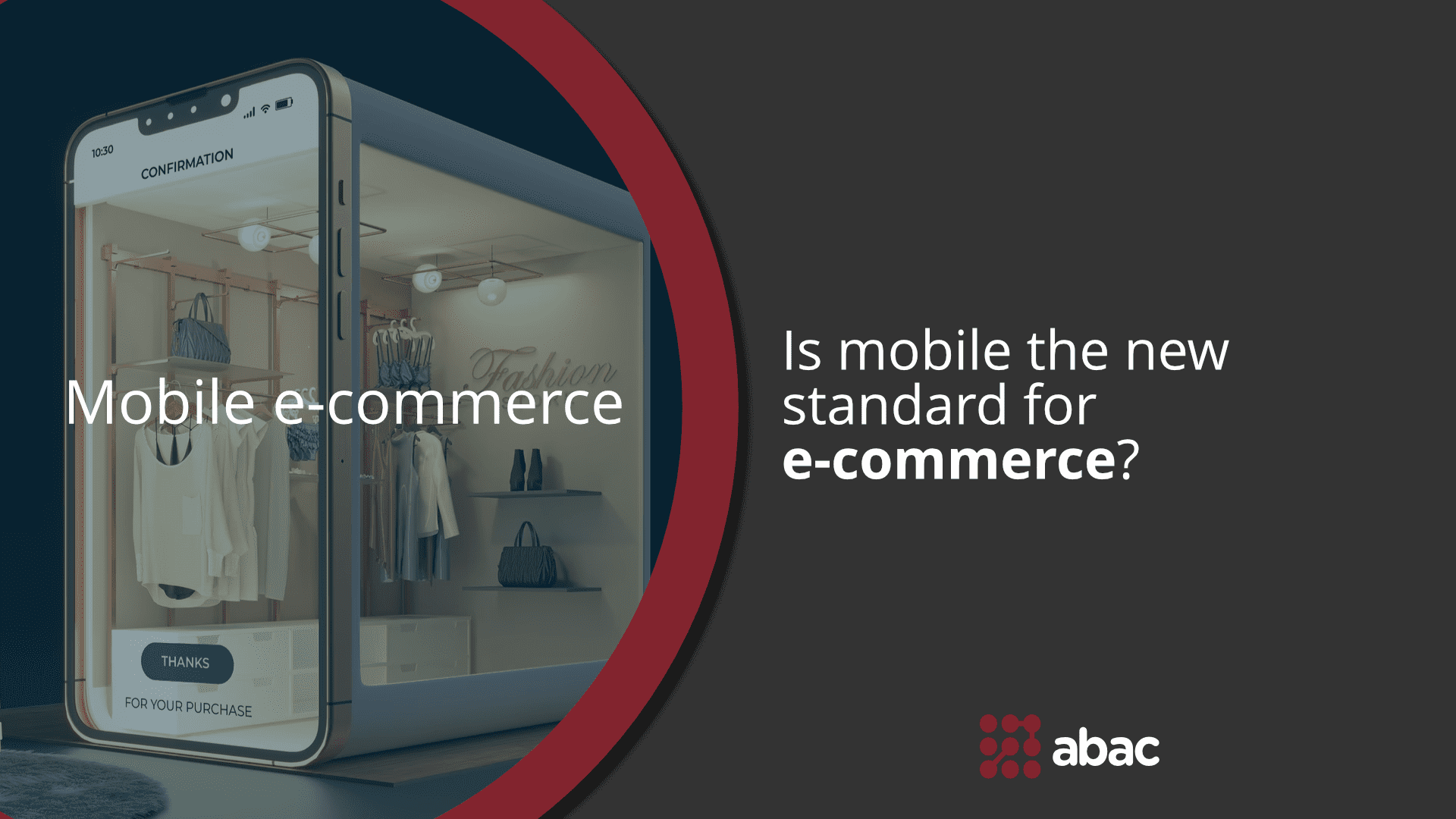TLDR. Yes! End of the article…jk 😀 We do intend on elaborating on that. But in a nutshell, mobile commerce or m-commerce is not just a trend but a phenomenon that’s here to stay. As smartphones become more central to how we shop online, communicate and inform ourselves, mobile commerce will likely become less of an option and more of a necessity for e-commerce retailers.
What is it?
Mobile commerce, also known as m-commerce, is the buying and selling of goods and services through mobile devices like smartphones/tablets and apps. It allows consumers to shop from anywhere, at any time, and from any device.

Source: Statista
Being so accessible, the figures above are not surprising: mobile commerce played a significant role in the global e-commerce market in 2022. According to Statista, the Asia-Pacific region led the way, with an estimated 72.9% of total retail e-commerce sales coming from mobile devices. North America and Western Europe also showed substantial growth in m-commerce sales, with percentages of 40.1% and 46.8%, respectively.
What it does?
Today, we have our entire life on our phones: we order food from our phones, pay bills, check our banking account and transfer money, buy and return stuff, consume content, check the weather, get driving directions and many, many more.
But as of recent years, mobile devices have also become a popular environment for online shopping — and that’s where mobile commerce steps in.
Also called m-commerce, it refers to any monetary transaction completed using a mobile device, such as a cell phone or tablet. Technology has made it easier for us to shop on-the-go from, basically, anywhere. The rise of smartphones has paved the way for m-commerce, which has become increasingly popular over the years. In fact, according to recent statistics, m-commerce sales are expected to make up close to 70% of retail e-commerce sales by 2024.
How to use it
As a business owner, an entrepreneur or an average Joe, and dwelling on the thought of opting for a m-commerce solution for your idea of an app, take into consideration the following aspects:
- Will your future users visit your app +5 times a day? If so, then it makes more sense to start with a mobile app. It is way more convenient, faster to access, and keeps users up to date with the notifications option.
- Do you care about app’s speed? Mobile apps are faster than web apps. The reason for this is that mobile apps store user’s data settings locally on the phone. Web apps, on the other hand, download the data from servers. In the case of performance, the user’s experience will be best when using native mobile apps.
- How often will people be using your product offline? Limited access to the internet is still a common problem, depending on the region. If you want to reach locations where internet connection is a problem, developing a web app may not be a good option. It may concern specific markets or just locations – maybe people will often use your app in places like beaches, forests, trains. In this case too, mobile app surpasses web platforms (as an example, Tripadvisor app enables you to download a city guide when you are traveling abroad, meaning you don’t need to google the most visited places, best restaurants nearby, or even a map).
When to use it
As seen in the above chart, the figures highlight the importance of retailers prioritizing mobile optimization to stay competitive in the e-commerce landscape.
Not long ago, creating mobile apps and/or switching to mobile-friendly platforms was seen as an option; but as the cost of going mobile drops, more and more companies are able to reap the benefits. So, whether you’re a big or small business, mobile commerce can help you scale your business.
In fact, the very nature of m-commerce means that it has certain capabilities that you simply can’t find with e-commerce, such as: mobility (considering most people never leave the house without their phone, m-commerce makes online shopping far more convenient), reachability (online retailers can reach a wider range of customers even when they’re on the go with the ability to send customers push notifications) and location-tracking (m-commerce apps and online stores can pinpoint user locations using GPS technology and Wi-Fi, which helps provide content that is personalized and location-specific).
Pros
- M-commerce provides the opportunity to engage with customers in real-time. With the help of mobile apps and push notifications, businesses can send alerts to customers about new products, discounts and promotions.
- This brings us to another benefit, meaning that mobile apps are more likely to drive engagement from users. By optimizing your mobile app to retarget loyal customers, using incentives such as promotions and discounts, you can reward app shoppers exclusively. This builds a flow of communication and loyalty and surely one wants both, right?
- On the other hand, mobile commerce also offers a personalized shopping experience, optimizing product placements and promotional campaigns. Retailers can use data from customers’ mobile devices to provide personalized recommendations and offers, which can increase sales.
- M-commerce helps businesses reach new customers through easy integration with social media platforms.
- If your idea can benefit from connecting users with more information immediately, building a mobile app will make more sense. A mobile app offers more interactive, real-time experience and better adjusts to the on-demand on-the-go needs of users. So now the poles have switched: building a website (web app) can be your second step to grab a larger market share.
Cons
Despite its many benefits, m-commerce does have some disadvantages. One of the biggest challenges is the screen size. While mobile devices are convenient, they can be limiting when it comes to browsing websites. This can result in a poor user experience, which may lead to some customers not completing their purchases.
Mobile devices also have limited storage capacity, which can impact the amount of data that businesses can store on a customer’s device. It can be problematic when it comes to storing large files, such as videos and images.
Conclusions
In conclusion, mobile commerce is rapidly becoming the new standard for e-commerce. Its convenience, accessibility and personalized shopping experience make it an attractive option for consumers. Of course, m-commerce is only a slice of the pie. Keep in mind that maintaining an effective omnichannel strategy requires that your mobile website or app weaves effortlessly into other channels, rather than standing alone.
Remember that mobile commerce is all about meeting your customers where they are and giving them a convenient, yet memorable experience.
Now, it’s up to you to decide if you want to join the trend that is here to stay. As for the cost of building mobile solutions, the cost varies, depending on the features, level of customization and complexities. But no worries, we have already delivered such solutions and can be your partner in this journey.
Sources:
- https://www.adjust.com/glossary/m-commerce/
- https://www.bigcommerce.com/articles/ecommerce/mobile-commerce/
- https://www.insiderintelligence.com/insights/mobile-commerce-shopping-trends-stats/
- https://clikfocus.com/blog/11-reasons-why-mcommerce-future-ecommerce
- https://www.forbes.com/sites/forbesbusinesscouncil/2023/03/28/m-commerce-a-new-sector-with-tremendous-growth/
- https://www.uptech.team/blog/m-commerce-overview

